#mathsai
Text
Mathematical Dimensions: An In-Depth Overview

Dimensions are a fundamental concept in mathematics that help us understand the size, shape, and structure of objects and spaces. In this guide, we will explore them in various contexts, from the basic concept of dimension in geometry to higher-dimensional spaces and their applications in real-world scenarios.
Understanding Dimensions:
In mathematics, a dimension is a measure of the number of coordinates required to locate a point within a space. The dimension of a space is closely related to the number of independent directions in which movement is possible.
One-Dimensional Space:
A one-dimensional space is the simplest concept of dimension. Points in one-dimensional space are located using a single coordinate, typically denoted as "x."
Two-Dimensional Space:
A two-dimensional space extends the concept to a plane. It is represented by two coordinates, usually denoted as "x" and "y." Geometry and coordinate geometry extensively deal with two-dimensional spaces.
Three-Dimensional Space:
The fundamental nature of the physical world finds its most accurate description within a three-dimensional spatial framework.In this context, we employ three coordinates, typically referred to as "x," "y," and "z," to establish the precise location of a point.. Here, three coordin. This space allows us to visualize objects with depth, such as cubes, spheres, and other three-dimensional shapes.
Vector Spaces and Linear Algebra:
A three-dimensional space most accurately characterizes the physical realm. The dimension of a vector space is a pivotal metric, denoting the smallest count of vectors essential to collectively span the entirety of the space. This concept finds direct relevance in Euclidean space, where the dimension corresponds to the quantity of coordinates necessary for pinpointing a specific location within that space.
Fractals and Non-Integer Dimensions:
Not all dimensions are integers. Fractals are intricate mathematical structures with non-integer dimensions. Fractal dimension quantifies how space is occupied by fractal entities. The fractal dimension lies between the object's topological dimension (like 1D, 2D, etc.) and its Hausdorff dimension, which quantifies the object's complexity.
String Theory and Extra Dimensions:
In theoretical physics, string theory suggests the existence of more than the usual three dimensions. It proposes that the universe has extra dimensions beyond our perception. These dimensions could be compactified, meaning and they are so small that we don't directly observe them in our macroscopic world.
Practical Applications:
Dimensions have practical applications in various fields, including computer graphics, computer-aided design (CAD), architecture, and more. Understanding dimensions is essential for creating accurate representations of real-world objects and spaces in these domains.
In conclusion, they are a foundational concept in mathematics that underpins our understanding of space, shape, and structure. From one-dimensional lines to multi-dimensional spaces, and dimensions, fundamental tool used across various mathematical disciplines. They have far-reaching applications in the real world, from physics to engineering. As a result of this, we gain a deeper insight into the fundamental nature of our universe. Explore Maths.ai for insightful discussions on diverse mathematical dimensions and their real-world applications.
0 notes
Text
Know Geometry: Concepts, Examples, and Methods

Geometry is a fundamental branch of mathematics that explores the properties and relationships of shapes, sizes, and space. From basic shapes to complex spatial configurations, geometry plays a crucial role in various fields such as architecture, engineering, art, and science. In this comprehensive guide, we will delve into the core concepts of geometry, provide illustrative examples, and outline essential methods. Whether you're a student seeking to deepen your understanding or an AI-based math enthusiast, this guide will serve as an invaluable resource.
Basic Concepts of Geometric
Geometry begins with fundamental concepts that lay the groundwork for more advanced topics. These include:
Point:
A point is a location in space, represented by a dot. It has no size, shape, or dimensions.
Line:
A line is a straight path that extends infinitely in both directions.
Plane:
A plane is a flat, two-dimensional surface that extends infinitely. At least three non-collinear points determine it.
Angle:
An angle is formed when two rays share a common endpoint (vertex). Angles are measured in degrees or radians.
Types of Angles:
Angles can be classified into various types based on their measurements and relationships:
Acute Angle:
An angle measuring less than 90 degrees.
Right Angle:
An angle measuring exactly 90 degrees.
Obtuse Angle:
An angle measuring more than 90 degrees but less than 180 degrees.
Straight Angle:
An angle measuring exactly 180 degrees.
Reflex Angle:
An angle measuring more than 180 degrees but less than 360 degrees.
Types of Polygons:
Polygons are closed shapes with straight sides. They can be categorized based on the number of sides they possess:
Triangle: A polygon with three sides.
Quadrilateral: A polygon with four sides.
Pentagon: A polygon with five sides.
Hexagon: A polygon with six sides.
Heptagon (Septagon): A polygon with seven sides.
Octagon: A polygon with eight sides.
Nonagon: A polygon with nine sides.
Decagon: A polygon with ten sides.
Congruence and Similarity:
Congruent shapes have the same size and shape, while similar shapes have the same shape but possibly different sizes. Methods to determine congruence and similarity include:
Side-Side-Side (SSS) Criterion:
Two triangles are congruent if their corresponding sides are proportional.
Side-Angle-Side (SAS) Criterion:
If two sides and the included angle of one triangle are congruent to the corresponding sides and angle of another triangle, the triangles are congruent.
Angle-Angle (AA) Criterion:
If two angles of one triangle are congruent to two angles of another triangle, the triangles are similar.
Side-Side-Angle (SSA) Criterion:
SSA is a similarity criterion that requires additional conditions to establish similarity.
The Pythagoras Theorem:
The Pythagoras theorem is a fundamental concept in geometry that relates the sides of a right triangle:
In a right triangle, the square of the length of the hypotenuse (the side opposite the right angle) is equal to the sum of the squares of the lengths of the other two sides.
Example: Consider a right triangle with legs of lengths 3 units and 4 units. The hypotenuse can be calculated using the Pythagorean theorem: (c^2 = a^2 + b^2), where (c) is the hypotenuse, (a) is the first leg, and (b) is the second leg. Substituting the values, we get (c^2 = 3^2 + 4^2), which simplifies to (c^2 = 9 + 16), and finally (c^2 = 25). Taking the square root of both sides, (c = 5). Therefore, the length of the hypotenuse is 5 units.
Coordinate Geometry:
Coordinate geometry involves using algebraic methods to study geometric shapes. It's the bridge between algebra and geometry. The Cartesian coordinate system is used to represent points on a plane.
Distance Formula:
The distance between two points ((x_1, y_1)) and ((x_2, y_2)) in a plane is given by (\sqrt{(x_2 - x_1)^2 + (y_2 - y_1)^2}).
Midpoint Formula:
The midpoint of a line segment between two points ((x_1, y_1)) and ((x_2, y_2)) is (\left(\frac{x_1 + x_2}{2}, \frac{y_1 + y_2}{2}\right)).
Three-Dimensional Geometry:
Geometry extends into three dimensions with concepts such as points, lines, and shapes in space. Common shapes include cubes, spheres, cylinders, and cones.
Trigonometry and Geometry:
Trigonometry is closely related to geometry and involves the study of the relationships between the angles and sides of triangles. Key trigonometric ratios include sine, cosine, and tangent.
Proofs of Geometry
Proofs are essential in geometry to demonstrate the validity of statements and theorems. Different methods of proof include direct proof, proof by contradiction, and proof by induction.
Geometry is a vast field that encompasses diverse concepts, methods, and applications. From understanding basic shapes to exploring complex spatial relationships, geometry plays a pivotal role in various disciplines. This guide has provided an overview of essential concepts, examples, and methods in geometry, empowering learners and AI-based systems to navigate and comprehend this fascinating mathematical realm. By mastering these fundamentals, you'll be well-equipped to tackle more advanced geometric challenges and contribute to the ever-evolving world of mathematics and its applications, use maths.ai to ace your education.
0 notes
Text
A Comprehensive Guide to Areas Related to Circles:

Understanding the properties and calculations related to circles is fundamental in mathematics. From the ancient times to modern-day applications, circles have played a crucial role in various fields such as geometry, physics, engineering, and more. In this article, we will delve into the world of areas related to circles, exploring the concepts, methods, and real-world applications, while providing step-by-step examples to facilitate understanding.
Basic Concepts
Before we delve into the methods of calculating areas related to circles, let's review some fundamental concepts:
Radius and Diameter:
The radius is the distance from the center of a circle to any point on its edge, while the diameter is twice the radius.
Circumference:
The circumference of a circle is the distance around its edge. It is given by the formula: (C = 2\pi r), where (r) is the radius.
Area of a Circle:
The area of a circle is the space enclosed by its edge. It is calculated using the formula: (A = \pi r^2), where (r) is the radius.
Methods for Calculating Areas Related to Circles
There are several scenarios where circles interact with other geometric shapes, leading to the calculation of areas related to circles. Let's explore two common methods for solving these problems: sector area and segment area calculations.
Method 1: Sector Area Calculation
A sector of a circle is a region enclosed by two radii and the corresponding arc. To calculate the area of a sector, follow these steps:
Step 1:
Identify the radius (r) and the angle (θ) (in radians) subtended by the sector at the center of the circle.
Step 2:
Use the formula for the area of a sector: (A_{\text{sector}} = \frac{1}{2} r^2 θ).
Example: Calculating the Area of a Sector
Consider a circle with a radius of 8 cm, and a sector subtending an angle of (60^\circ) at the center. Let's calculate the area of the sector.
Step 1: Given (r = 8) cm and (θ = 60^\circ), convert (θ) to radians: (θ = \frac{60}{180} \pi = \frac{\pi}{3}).
Step 2: Use the formula (A_{\text{sector}} = \frac{1}{2} r^2 θ):
[A_{\text{sector}} = \frac{1}{2} \times 8^2 \times \frac{\pi}{3} = \frac{64}{3} \pi \approx 67.03 \, \text{cm}^2].
Methods for Calculating Areas Related to Circles
A segment of a circle is the region enclosed by a chord and the arc it subtends. To calculate the area of a segment, use these steps:
Step 1:
Identify the radius (r), the angle (θ) (in radians), and the length of the chord.
Step 2:
Calculate the area of the corresponding sector using (A_{\text{sector}} = \frac{1}{2} r^2 θ).
Step 3:
Use the formula (A_{\text{segment}} = A_{\text{sector}} - \text{Area of Triangle}), where the triangle is formed by the two radii and the chord.
Example: Calculating the Area of a Segment
Consider a circle with a radius of 10 cm, and a chord of length 12 cm, subtending an angle of (120^\circ) at the center. Let's calculate the area of the segment.
Step 1:
Given (r = 10) cm, (θ = 120^\circ), and chord length (c = 12) cm. Convert (θ) to radians: (θ = \frac{120}{180} \pi = \frac{2}{3} \pi).
Step 2:
Calculate the area of the sector using (A_{\text{sector}} = \frac{1}{2} r^2 θ):
[A_{\text{sector}} = \frac{1}{2} \times 10^2 \times \frac{2}{3} \pi = \frac{100}{3} \pi \approx 104.72 \, \text{cm}^2].
Step 3:
Calculate the area of the triangle using its base and height:
[A_{\text{triangle}} = \frac{1}{2} \times c \times r = \frac{1}{2} \times 12 \times 10 = 60 \, \text{cm}^2].
Step 4:
Calculate the area of the segment using (A_{\text{segment}} = A_{\text{sector}} - A_{\text{triangle}}):
[A_{\text{segment}} = \frac{100}{3} \pi - 60 = \frac{100}{3} \pi - \frac{180}{3} = \frac{100 - 180}{3} \pi = -\frac{80}{3} \pi \approx -83.77 \, \text{cm}^2].
Real-World Applications
Areas related to circles have numerous applications in various fields. Some examples include:
Construction:
Architects and engineers use circle-related calculations to design circular structures like domes, arches, and circular bridges.
Manufacturing:
Circular patterns and components are common in manufacturing industries. Calculations related to areas of circular sections are crucial for designing parts such as gears and bearings.
Landscaping:
Circular lawns, fountains, and other landscaping features often require calculations of circular areas.
Physics:
Circular motion calculations are crucial in physics, where understanding areas of circular sections helps analyze rotational motion, angular velocity, and more.
Art and Design:
Artists and designers often use circular patterns and shapes in their creations. Calculating areas related to these circles contributes to achieving desired aesthetics.
Areas related to circles hold a significant place in mathematics due to their practical applications and intricate geometric properties. In this article, we explored two methods for calculating areas of sectors and segments, providing step-by-step examples for each. These calculations find relevance in various real-world scenarios, underscoring the importance of mastering these concepts. From construction to physics, circular calculations are essential tools that enable us to understand and shape the world around us. So whether you're a student aiming to ace your maths exams or a professional looking to apply mathematical principles in your field, maths.ai is a valuable asset that opens doors to a myriad of possibilities.
0 notes
Text
Solving Linear Equations with Two Variables:
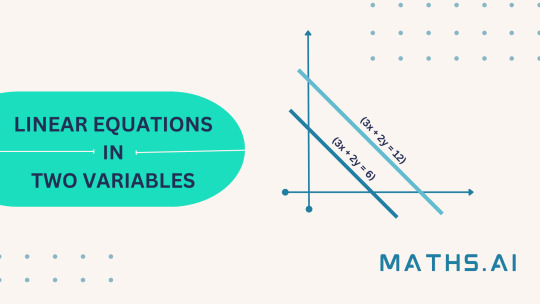
Solving linear equations with two variables is a fundamental skill in algebra that has real-world applications in various fields such as physics, economics, and engineering. These equations involve two unknowns and can be graphically represented as straight lines on a coordinate plane. In this article, we will explore two common methods for solving equations: the substitution method and the elimination method. Through step-by-step examples.
Method 1: Substitution Method
The substitution method involves solving one equation for one variable and substituting that expression into the other equation. Here's a detailed example to illustrate the process:
Example
Solve the following system of linear equations using the substitution method:
1. \(2x + y = 8\)
2. \(3x - 2y = 1\)
Step 1:
Solve one equation for one variable.
From equation (1), solve for \(y\):
\[y = 8 - 2x\]
Step 2:
Substitute the expression for \(y\) into the other equation.
Substitute \(y = 8 - 2x\) into equation (2):
\[3x - 2(8 - 2x) = 1\]
Step 3:
Solve for \(x\).
\[3x - 16 + 4x = 1\]
\[7x = 17\]
\[x = \frac{17}{7}\]
Step 4:
Substitute \(x\) value back to find \(y\).
Using the value of \(x\) in \(y = 8 - 2x\):
\[y = 8 - 2 \left(\frac{17}{7}\right) = \frac{3}{7}\]
So, the solution for the system of equations is \(x = \frac{17}{7}\) and \(y = \frac{3}{7}\).
Method 2: Elimination Method
The elimination method involves adding or subtracting the equations to eliminate one of the variables, making it easier to solve for the remaining variable. Let's solve the same system of equations using the elimination method:
Example
Solve the system of linear equations using the elimination method:
1. \(2x + y = 8\)
2. \(3x - 2y = 1\)
Step 1:
Multiply the equations by suitable constants to make the coefficients of one of the variables equal.
Multiply equation (1) by 2 and equation (2) by 1 to make the coefficients of \(y\) equal:
\[2(2x + y) = 2 \cdot 8 \implies 4x + 2y = 16\]
\[3x - 2y = 1\]
Step 2:
Add the equations to eliminate \(y\).
Add the two equations:
\[4x + 2y + 3x - 2y = 16 + 1\]
\[7x = 17\]
\[x = \frac{17}{7}\]
Step 3:
Substitute \(x\) value to find \(y\).
Using the value of \(x\) in equation (1):
\[2x + y = 8\]
\[2 \left(\frac{17}{7}\right) + y = 8\]
\[\frac{34}{7} + y = 8\]
\[y = \frac{3}{7}\]
The solution for the system of equations is \(x = \frac{17}{7}\) and \(y = \frac{3}{7}\).
.
Solving linear equations with two variables is a crucial skill in algebra, with applications extending to diverse fields. The substitution and elimination methods provide effective strategies for finding solutions, and through step-by-step examples, we've demonstrated how these methods work. With the advent of AI-based tools like Maths.ai, students now have access to personalized, interactive guidance that enhances their understanding and problem-solving abilities. As technology continues to evolve, the learning experience for mathematics is becoming more engaging and accessible, empowering students to excel in their studies and beyond.
0 notes
Text
Mathematical Reasoning: A Complete Guide
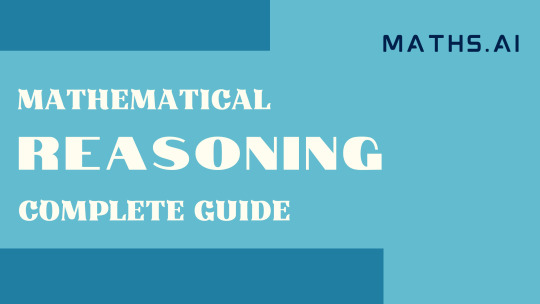
Mathematical Reasoning is the foundation of problem-solving and critical thinking in mathematics. It involves the ability to analyze, deduce, and draw conclusions from mathematical concepts, principles, and relationships. In this guide, we will explore the key aspects of mathematical reasoning, provide examples to illustrate its application, and discuss effective methods for developing strong mathematical reasoning skills.
Key Aspects of Mathematical Reasoning
Logical Deduction:
Mathematical reasoning involves using logical deduction to arrive at conclusions based on given information or premises. It requires the ability to follow a chain of reasoning step by step, ensuring that each step is based on sound logic.
Pattern Recognition:
Recognizing patterns and relationships is crucial for mathematical reasoning. Identifying trends and regularities helps in making conjectures and predictions, and aids in solving problems efficiently.
Abstraction:
Abstraction involves generalizing specific cases into broader concepts. It allows us to work with generalized properties rather than specific instances, making problem-solving more versatile.
Inductive and Deductive Reasoning:
Inductive reasoning involves making generalizations based on a set of specific observations, while deductive reasoning uses established principles to draw specific conclusions. Both are important for mathematical reasoning.
Counter examples:
Counterexamples are instances that disprove a conjecture or statement. Considering counterexamples is crucial to test the validity of a mathematical claim.
Proofs:
Mathematical proofs are rigorous arguments that establish the truth of a statement or proposition. Constructing and understanding proofs is a fundamental aspect of mathematical reasoning.
Examples Illustrating Mathematical Reasoning
Example: Fibonacci Numbers
Consider the Fibonacci sequence: 0, 1, 1, 2, 3, 5, 8, ..
By observing the pattern, we notice that each term is the sum of the previous two terms. This pattern leads to a conjecture: the nth term is the sum of the (n-1)th and (n-2)th terms. We can prove this by mathematical induction.
Example: Prime Numbers
Prime numbers are positive integers greater than 1 that have no divisors other than 1 and themselves. By using deductive reasoning, we can prove that there are infinitely many prime numbers. Suppose there are only finitely many primes. We can then consider the number obtained by multiplying all existing primes and adding 1. This number is either prime itself (contradicting the assumption) or has a prime factor that is not in our list, leading to a contradiction.
Example: Pythagorean Theorem
The Pythagorean Theorem states that in a right-angled triangle, the square of the length of the hypotenuse is equal to the sum of the squares of the other two sides.
Mathematical Reasoning: One way to prove this theorem is using geometric reasoning. Consider a square with side lengths a + b, where a and b are the lengths of the triangle's legs. The square can be divided into smaller squares and
rearranged to show that the area of the large square is equal to the sum of the areas of the two smaller squares.
Methods for Developing Strong Mathematical Reasoning Skills
Practice Problem-Solving:
Regularly solve a variety of mathematical problems. Start with simpler problems and gradually work your way up to more complex ones. This will help you develop pattern recognition and logical deduction skills.
Analyze Proofs:
Study different types of mathematical proofs. Understand the structure of a proof, from the assumptions to the conclusion. This will enhance your ability to construct rigorous arguments.
Explore Counterexamples:
When encountering a new conjecture, try to find counterexamples that might disprove it. This practice will help you refine your reasoning skills and think critically about mathematical statements.
Work Collaboratively:
Discuss mathematical problems and concepts with peers or mentors. Explaining your reasoning to others and listening to their perspectives can provide new insights and broaden your understanding.
Engage with Mathematical Literature:
Read mathematical books, papers, and articles. Exposing yourself to various mathematical ideas and approaches will expand your toolkit for reasoning.
Participate in Math Competitions:
Joining math competitions or problem-solving clubs can challenge you to think creatively and critically under time constraints.
Mathematical Reasoning is a fundamental skill that underlies all branches of mathematics. It involves logical deduction, pattern recognition, abstraction, and the ability to construct and understand proofs. By engaging with examples and following effective methods, you can develop strong mathematical reasoning skills that will serve you well in both academic and real-world problem-solving scenarios. Regular practice, thoughtful analysis, and a curious mindset are key to mastering this essential skill. Visit maths.ai to help in solving maths problems.
0 notes
Text
Solve Arithmetic Progressions: A Step-by-Step Guide

Arithmetic progressions, commonly known as arithmetic sequences, are a fundamental concept in mathematics that appear in various fields like algebra, calculus, and computer science. They play a crucial role in understanding patterns and relationships between numbers. In this article, we will explore how to solve arithmetic progressions step by step with the assistance of maths.ai. We will begin by defining arithmetic progressions and then delve into solving them through an illustrative example.
Understanding Arithmetic Progressions
An arithmetic progression is a sequence of numbers in which the difference between any two consecutive terms is constant. This constant difference is known as the common difference (d). The terms of an arithmetic progression are usually denoted by 'a', 'a + d', 'a + 2d', and so on, where 'a' represents the first term.
The general formula for finding the 'n'th term (the term at position 'n') of an arithmetic progression is given by:
\[ a_n = a + (n-1)d \]
Where:
- \( a_n \) is the 'n'th term
- 'a' is the first term
- 'd' is the common difference
- 'n' is the position of the term in the sequence
Solving an Arithmetic Progression Step by Step
Let's consider an example
Find the 10th term of an arithmetic progression where the first term is 3 and the common difference is 5.
Step 1: Identify Given Values
- First term (a) = 3
- Common difference (d) = 5
- Position of the term (n) = 10
Step 2: Apply the Formula
o calculate the 'n'th term:
\[ a_n = a + (n-1)d \]
\[ a_{10} = 3 + (10-1) \times 5 \], \[ a_{10} = 3 + 9 \times 5 \], \[ a_{10} = 3 + 45 \]
\[ a_{10} = 48 \]
"The 10th term of the arithmetic progression is 48."
Additional Information
the formula for the sum of the first 'n' terms of an arithmetic progression:
\[ S_n = \frac{n}{2} \times (2a + (n-1)d) \]
Where:
- \( S_n \) is the sum of the first 'n' terms
- 'a' is the first term
- 'd' is the common difference
- 'n' is the number of terms
Arithmetic progressions are an essential mathematical concept, and mastering them is crucial for building a strong foundation in mathematics. With the advent of AI-powered platforms like maths.ai, students have access to immediate assistance and step-by-step guidance to solve arithmetic progression problems efficiently. The combination of well-defined formulas and the convenience of AI technology can significantly enhance students' problem-solving skills and mathematical comprehension. Whether it's finding specific terms or calculating sums, the power of AI in education is undeniable, offering personalized support and transforming the way students learn by making maths simple.
1 note
·
View note
Text
How to Solve Log: A Step-by-Step Guide with Maths.ai
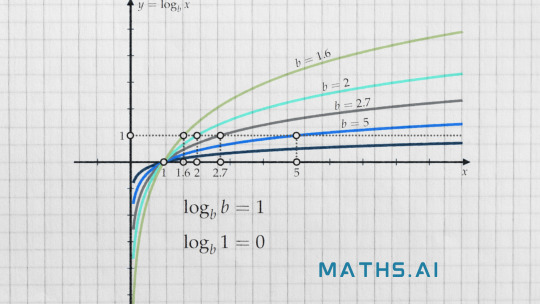
Welcome to Maths.ai, your reliable AI-based companion for solving challenging math problems! In this article, we'll dive into the world of logarithms, exploring their properties and presenting a comprehensive step-by-step guide to solve log equations. With the assistance of our Maths.ai, we'll walk you through the process and provide real-life examples to solidify your understanding.
Section 1: Understanding Logarithms
Before we jump into solving logarithmic equations, it's crucial to grasp the concept of logarithms. A logarithm is the inverse operation of exponentiation. In other words, it answers the question, "What exponent do I need to raise a particular base to, to obtain a given value?" The notation for a logarithm is as follows:
If \(b^x = y\), then \(\log_{b}(y) = x\).
Here, \(b\) is the base, \(x\) is the exponent, and \(y\) is the result of the exponentiation. Logarithms are particularly useful in solving problems involving exponential growth, decay, and complex calculations.
Section 2: Properties of Logarithms
Before we proceed with solving logarithmic equations, let's review some key properties of logarithms:
1. Product Rule: \(\log_b(xy) = \log_b(x) + \log_b(y)\)
2. Quotient Rule: \(\log_b\left(\frac{x}{y}\right) = \log_b(x) - \log_b(y)\)
3. Power Rule: \(\log_b(x^n) = n \cdot \log_b(x)\)
These properties allow us to manipulate logarithmic expressions and simplify complex equations into more manageable forms.
Section 3: Solving Basic Logarithmic Equations
Now, let's delve into solving basic logarithmic equations. Consider the equation:
\(\log_2(x) = 3\)
Step 1: Recognize the Base and Result
Identify the base of the logarithm, which is \(2\) in this case, and the result of the logarithmic expression, which is \(3\).
Step 2: Rewrite the Equation in Exponential Form
To solve for \(x\), rewrite the equation in exponential form:
\(2^3 = x\)
Step 3: Evaluate the Exponent
Compute the result of \(2^3\):
\(2^3 = 8\)
Step 4: Determine the Solution
The value of \(x\) that satisfies the equation \(\log_2(x) = 3\) is \(8\).
Section 4: Solving Logarithmic Equations with Variables
Now, let's tackle a more complex logarithmic equation involving variables:
\(\log_3(x+2) - \log_3(x) = 2\)
Step 1: Combine Logarithms
Apply the quotient rule to combine the two logarithms:
\(\log_3\left(\frac{x+2}{x}\right) = 2\)
Step 2: Express Equation in Exponential Form
Rewrite the equation in exponential form:
\(3^2 = \frac{x+2}{x}\)
Step 3: Solve for \(x\)
To solve for \(x\), isolate \(x\) on one side of the equation:
\(9x = x + 2\)
Step 4: Simplify and Solve
Combine like terms and isolate \(x\) on one side:
\(9x - x = 2\)
\(8x = 2\)
\(x = \frac{2}{8} = \frac{1}{4}\)
Step 5: Verify Solution
Check if the solution \(x = \frac{1}{4}\) is valid by ensuring that \(x\) is positive in the original equation:
\(\log_3\left(\frac{\frac{1}{4}+2}{\frac{1}{4}}\right) - \log_3\left(\frac{1}{4}\right) = \log_3\left(\frac{\frac{9}{4}}{\frac{1}{4}}\right) - \log_3\left(\frac{1}{4}\right) = \log_3(9) - \log_3(1) = 2 - 0 = 2\)
The solution \(x = \frac{1}{4}\) satisfies the original equation.
Section 5: Solving Logarithmic Equations with Advanced Techniques
In more advanced problems, logarithmic equations may require additional techniques for simplification. Let's consider an example:
\(\log_2(x^2 - 9) - \log_2(x+3) = 1\)
Step 1: Combine Logarithms
Apply the quotient rule to combine the two logarithms:
\(\log_2\left(\frac{x^2 - 9}{x+3}\right) = 1\)
Step 2: Express Equation in Exponential Form
Rewrite the equation in exponential form:
\(2^1 = \frac{x^2 - 9}{x+3}\)
Step 3: Solve for \(x\)
To solve for \(x\), isolate the expression on one side of the equation:
\(2(x+3) = x^2 - 9\)
Step 4: Expand and Simplify
Expand the left side of the equation:
\(2x + 6 = x^2 - 9\)
Step 5: Move All Terms to One Side
Move all terms to one side of the equation to obtain a quadratic equation:
\(x^2 - 2x - 15 = 0\)
Step 6: Factor and Solve
Factor the quadratic equation:
\((x-5)(x+3) = 0\)
Set each factor to zero and solve for \(x\):
\(x-5 = 0 \Rightarrow x = 5\)
\(x+3 = 0 \Rightarrow x = -3\)
Step 7: Verify Solutions
Check if the solutions \(x = 5\) and \(x = -3\) are valid by ensuring that the expressions inside the logarithms are positive:
For \(x = 5\):
\(\log_2(5^2 - 9) - \log_2(5+3) = \log_2(16) - \log_2(8) = 4 - 3 = 1\)
For \(x = -3\):
\(\log_2((-3)^2 - 9) - \log_2((-3)+3) = \log_2(0) - \log_2(0)\)
Since the expression inside the first logarithm is non-positive, the solution \(x = -3\) is invalid.
Congratulations! You have now mastered the art of solving logarithmic equations, thanks to the step-by-step guidance of Maths.ai . Remember the fundamental properties of logarithms and apply them to simplify and solve log equations. With practice, you'll become adept at handling logarithms and excel in your mathematical journey. Keep exploring the fascinating world of mathematics with the support of Maths.ai, your online maths tutor for all your maths-related support.
0 notes
Text
How to Solve Quadratic Equations: Maths.ai
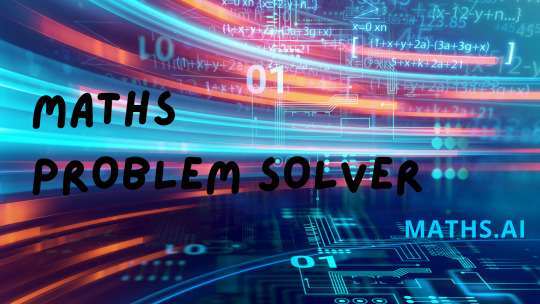
Quadratic equations are an essential part of algebra, and they often pose challenges for students when it comes to solving them. However, with the advent of artificial intelligence, learning and understanding complex maths problems has become more accessible than ever. Maths.ai, an AI-based website dedicated to assisting students in solving maths equations, introduces a powerful chatbot capable of guiding users through the process of solving quadratic equations. In this article, we will explore how to solve quadratic equations using the Maths.ai chatbot. It provides a comprehensive step-by-step guide to help students grasp this topic more effectively.
Understanding Quadratic Equations
Before diving into the solution process, it is essential to understand what a quadratic equation is and how it is represented. A quadratic equation is a second-degree polynomial equation in a single variable (usually denoted by "x"). It takes the general form:
ax^2 + bx + c = 0
where "a," "b," and "c" are constants, and "a" must not be equal to zero.
Introducing the Maths.ai Chatbot
Maths.ai is an intelligent virtual assistant designed to offer step-by-step guidance on various maths problems, including quadratic equations. By utilizing natural language processing and machine learning algorithms, the chatbot can understand user queries and provide personalized solutions, making it an invaluable tool for students seeking to improve their maths skills.
Step-by-Step Guide to Solving Quadratic Equations with Maths.ai
Now, let's delve into the process of solving quadratic equations using the Maths.AI chatbot. Here's a comprehensive step-by-step guide:
Step 1: Accessing the Chatbot
To get started, students can visit the Maths.ai website and locate the chatbot interface. Upon accessing it, the chatbot will greet the user and prompt them to enter the quadratic equation they wish to solve.
Step 2: Entering the Quadratic Equation
The user can input the quadratic equation in the standard form (ax^2 + bx + c = 0) directly into the chatbot's text box. The AI-powered chatbot will then analyze the equation and check for any errors in the input.
Step 3: Validating the Equation
After receiving the quadratic equation, the chatbot will verify if it is indeed a quadratic equation by checking that "a" is not equal to zero. If the equation is not in the proper form or violates any fundamental rules, the chatbot will provide feedback to the user, asking them to re-enter the equation correctly.
Step 4: Identifying the Coefficients
Once the chatbot validates the equation, it will identify and extract the values of "a," "b," and "c" from the entered quadratic equation.
Step 5: Computing the Discriminant
The chatbot will calculate the discriminant based on the coefficients "a," "b," and "c."
Step 6: Analyzing the Nature of Roots
The value of the discriminant (Δ) provides insight into the nature of the roots of the quadratic equation:The discriminant (Δ) is a crucial value in determining the nature of the roots of a quadratic equation. It is computed as follows:
Δ = b^2 - 4ac
a. If Δ > 0, the equation has two distinct real roots.
b. If Δ = 0, the equation has one real root (a repeated root).
c. If Δ < 0, the equation has two complex (non-real) roots.
The chatbot will inform the user about the nature of the roots based on the calculated discriminant.
Step 7: Calculating the Roots
Next, the chatbot will guide the user through the process of finding the roots of the quadratic equation based on the nature of the roots:
a. If the equation has two distinct real roots, the roots can be computed using the quadratic formula:
x = (-b ± √Δ) / 2a
b. If the equation has one real root (a repeated root), the root can be calculated as:
x = -b / 2a
c. If the equation has two complex (non-real) roots, the roots can be expressed in the form:
x = (-b ± √|Δ|i) / 2a
where "i" represents the imaginary unit (i.e., √-1).
Step 8: Presenting the Solutions
Finally, the chatbot will display the solutions of the quadratic equation to the user. It will provide both the exact values (in case of real roots) and the expressions (in case of complex roots) for better understanding.
In conclusion, quadratic equations are a fundamental concept in algebra, and solving them can be simplified with the assistance of Maths.ai. By following the step-by-step guide outlined in this article, students can effectively solve quadratic equations and gain a deeper understanding of the process. Maths.ai's AI-based chatbot is revolutionizing the way students approach math problems, making learning more engaging and accessible than ever before. As technology continues to advance, we can expect further innovations like the Maths.ai to transform the landscape of education.
0 notes
Text
"Ace Maths Exams: Supercharge Your Preparations with Maths.ai!"
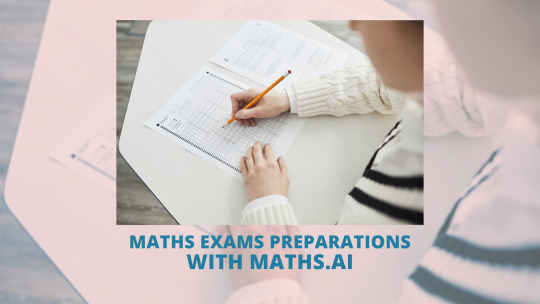
Mathematics has always been a challenging subject for many students. The complexities of equations, formulas, and concepts often lead to anxiety and frustration. With the rapid advancements in technology, particularly in the field of Artificial Intelligence (AI). There is now a powerful ally for students seeking to conquer maths difficulties - AI-powered online tutoring. In this article, we will explore how maths.ai is transforming the landscape of maths learning and helping students in maths exams preparations.
Learning Maths: Maths:ai
Conventional approaches to teaching mathematics have historically centered on in-person lectures, textbooks, and repetitive exercises. Although these methods have proven effective for certain learners, they might not fully accommodate the unique requirements and preferred learning methods. This is where maths.ai steps in, bridging the divide between standardized teaching and tailored, individualized learning experiences.
1. Personalized Learning
Maths.ai is a groundbreaking online platform that harnesses the power of AI algorithms to provide personalized learning experiences for students. By analyzing the student's strengths, weaknesses, and learning patterns, maths.ai tailors its approach to address specific problem areas, ultimately enhancing the student's comprehension and retention of mathematical concepts.
Personalization is achieved through various techniques, including adaptive learning, data analytics, and machine learning. Maths.ai continuously collects data on the student's performance. This not only boosts the student's confidence in the studies but also help them in maths exams preparations.
2. Interactive and Engaging Experience
Traditional maths learning often struggles to captivate students' attention, leading to disinterest and a lack of motivation. Maths.ai overcomes this challenge by offering interactive and engaging lessons that employ multimedia elements, simulations, and gamification. These features make learning math enjoyable and exciting, transforming the way students approach the subject.
3. Real-time Assessment and Feedback
One of the most significant advantages of maths.ai is its ability to provide real-time assessment and feedback to students. Traditional learning methods often leave students waiting for their exams to receive feedback from their teachers. With maths.ai, students receive immediate feedback on their performance, helping them identify areas that require improvement. It is effectively helping students in their maths exams preparations.
The AI algorithm not only points out mistakes but also offers step-by-step explanations and alternative approaches to solving problems. This personalized feedback plays a vital role in boosting the student's confidence and comprehension, as they can rectify errors and gain a deeper understanding of the concepts.
4. 24/7 Accessibility
Maths.ai breaks the barriers of time and space, making maths help available to students 24/7. Whether it's late at night before an exam or early in the morning before school, students can access the platform whenever they need assistance. This flexibility empowers students to study at their own pace and on their own schedule, eliminating the stress of tight deadlines.
The platform's accessibility also ensures that students from diverse backgrounds, including those in remote areas, have equal opportunities to access quality math education.
5. Building Self-directed Learners
Maths.ai empowers students to become self-directed learners by encouraging them to take control of their learning experience. The platform provides students with the flexibility to choose the topics they want to focus on. They could revisit lessons as many times as needed. This freedom fosters a sense of ownership over their education, enhancing their motivation and dedication to excel in math.
In conclusion, maths.ai is transforming the way students learn mathematics by providing personalized, interactive, and engaging online tutoring. By harnessing the power of AI, this innovative platform adapts to each student's learning needs, offers real-time assessment and feedback, and identifies knowledge gaps to provide targeted support. With 24/7 accessibility and the ability to build self-directed learners, it is empowering students to confidently tackle maths exams and excel in their academic journey. Embracing maths.ai for maths learning is not just a technological advancement; it is a transformative step towards a more inclusive and effective education system.
So, why wait? Get ready to ace your math exams with the help of your favourite maths teacher!
0 notes
Text
Introducing Maths.ai: Your Favourite Maths Teacher
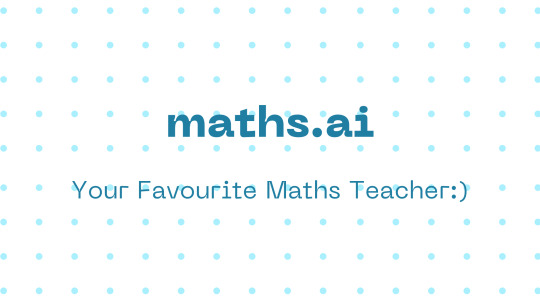
Welcome to the world of Mathematics, where numbers and equations come together to unlock the secrets of the universe. If you've ever found yourself struggling with mathematical concepts, fear not! Today, we go through the fascinating realm of maths.ai and how it can transform the way students learn and excel in maths. This article will explore the key ways in which maths.ai can enhance your math journey, from personalized learning to intelligent tutoring systems. So, let's embark on this mathematical adventure with a cool maths teacher and embrace the future of education!
How It Works:
Maths.ai is a user-friendly interface, making it accessible to students of all ages and skill levels. To get started, students can simply enter their maths problem into the system. The AI algorithms then analyse the problem, breaking it down into manageable steps. Maths.ai provides a step-by-step solution, along with explanations and relevant formulas, empowering students to understand the underlying concepts.
Intelligent Tutoring Systems (ITS)
Gone are the days of one-size-fits-all tutoring. AI-driven Intelligent Tutoring Systems (ITS) take tutoring to the next level by offering customised, interactive, and real-time guidance to students. Maths.ai leverages machine learning algorithms to understand students' queries. The ai based maths teacher provides step-by-step solutions, and offer instant feedback, nurturing a deeper understanding of math concepts.
Overcoming Math Anxiety:
Math anxiety is a common hurdle that many students face. Maths.ai can help alleviate this anxiety by offering a non-judgmental, patient, and supportive learning environment. This tool adapt to the student's pace, provide positive reinforcement, and instill confidence, turning math into a friend rather than a foe.
Natural Language Processing (NLP) for Math:
For many students, deciphering word problems can be a daunting task. However, AI, specifically Natural Language Processing (NLP), comes to the rescue! NLP-powered tools can comprehend and interpret mathematical language, simplifying complex problems and aiding students in comprehending the underlying concepts.
Supplementing Classroom Education
While maths.ai is an incredible resource, it is essential to acknowledge its limitations. The system relies on predefined algorithms and may not address every unique problem or approach. Moreover, students should use the platform as a learning tool rather than a substitute for active engagement in the learning process.
In conclusion, the amalgamation of AI and mathematics education has the potential to revolutionize the way students learn and excel in this critical subject. From personalized learning and intelligent tutoring to interactive platforms. Maths.ai offers abundant of tools and approaches that cater to individual needs and preferences. Embrace the power of AI and embark on an exciting journey towards becoming a confident and proficient mathematician with the help of your maths teacher. As technology continues to advance, the future of mathematics education is indeed brighter than ever before.
So, gear up, math enthusiasts! Embrace the AI-powered future of education and unlock the wonders of mathematics like never before! Happy learning!
0 notes
Text
Maths Help at Fingertips: Maths.ai

Master your mathematics skills through maths.ai by getting maths help at fingertips!
In today's digital era, Artificial Intelligence (AI) is transforming various aspects of our lives, and education is no exception. The realm of mathematics, often considered challenging by students, has witnessed significant advancements through maths.ai. This platform offers personalised and accessible maths assistance, transforming the way students learn and excel in the subject. In this article, we will explore how maths.ai is shaping the future of maths education, the benefits it brings to students, and maths help at fingertips to master in mathematics concepts.
The Role of AI in Mathematics Education
Artificial Intelligence has transformed the way students learn and interact with mathematics. By harnessing the power of AI algorithms, maths.ai has provided personalised maths help tailored to individual learning styles and needs. Through adaptive learning systems, it can assess students' strengths and weaknesses, and generate customised learning paths to optimize learning outcomes.
Maths.ai employs various techniques such as machine learning, natural language processing, and computer vision to deliver an engaging and interactive learning experience. Machine learning algorithms analyse vast amounts of data to understand student' behaviour, track progress, and generate personalised recommendations.
The Benefits of Maths Education with the help of Maths.ai:
Education based on maths.ai offers numerous advantages for students. Firstly, the personalised nature of AI algorithms allows students to learn at their own pace and focusing on areas that require additional attention. This particular approach boosts students' confidence, reduces anxiety, and fosters a deeper understanding of mathematical concepts.
Moreover, maths.ai provides instant feedback, enabling students to identify and correct errors immediately. By receiving real-time explanations and guidance. Students can reinforce their understanding and avoid recurring mistakes, leading to a more efficient learning process. As a result, it enhances engagement by gamifying the learning experience.
Maths Help at Fingertips:
Maths.ai has transformed the way students seek maths help at fingertips. It allows students to solve maths problems simply by typing the equations. Its assistants provide step-by-step solutions and enabling students to learn the problem-solving process. Maths.ai utilises AI algorithms to adapt to students' learning needs and track progress.
Maths.ai allows students to learn at their own pace and overcome the challenges associated with the subject and enables students to develop strong mathematical skills and excel in their academic pursuits.
Artificial Intelligence has opened up a world of possibilities in mathematics education. By Maths.ai, students can access personalised maths help at fingertips, receive instant feedback, and engage in interactive learning experiences. The availability of online resources has made maths learning more accessible and convenient, and allowing students to learn at their own pace. As a result they could overcome the challenges associated with the subject. As maths.ai continues to advance, we can expect further enhancements in maths education. With maths help at their fingertips, students now have the tools they need to unlock their full potential and embrace the wonders of mathematics.
0 notes
Text
Maths.ai: Your Online Maths Tutor
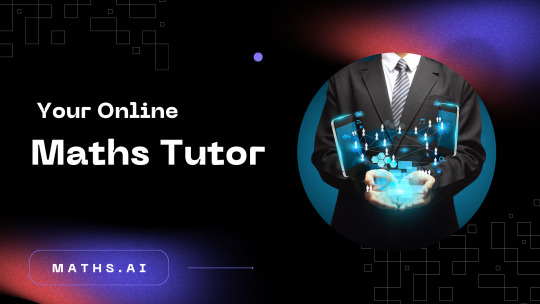
Mathematics is a subject that often poses challenges for students at various academic levels. Many students struggle to grasp mathematical concepts, understand complex equations, and solve problems effectively. In today's digital age, online learning has become increasingly popular, providing students with flexible and accessible resources. One innovation that has revolutionised the way students learn maths is maths.ai. This platform utilises artificial intelligence and advanced algorithms to offer personalised learning experiences, comprehensive study materials, and interactive problem-solving tools. In this article, we will explore the benefits and features of maths.ai and how it can help students excel in mathematics.
Personalized Learning:
Maths.ai leverages the power of artificial intelligence to provide personalised learning experiences. This platform utilises algorithms that analyse a student's strengths, weaknesses, and learning patterns. By tracking a student's progress, the website can generate customised study plans and recommend appropriate lessons and exercises. This tailored approach ensures that students focus on areas that require improvement and allows them to learn at their own pace, promoting a deeper understanding of mathematical concepts.
Interactive Problem Solving
Maths.ai incorporates interactive problem-solving tools that engage students and enhance their mathematical skills. This tool includes virtual manipulatives, graphing calculators, and step-by-step problem-solving guides. By providing students with interactive platforms, maths.ai fosters an active learning environment where students can experiment, explore, and applies mathematical concepts in a practical manner. The immediate feedback generated by this tool also helps students identify errors and rectify their mistakes, reinforcing their understanding of mathematical concepts.
Real-Time Assessments and Progress Tracking:
Maths.ai employs sophisticated assessment techniques to evaluate a student's progress accurately. Through automated grading and feedback mechanisms, students receive instant evaluations, enabling them to gauge their strengths and weaknesses. Moreover, the progress tracking feature allows students to monitor their improvement over time, which can boost their motivation and provide a sense of accomplishment.
Adaptive Learning:
Adaptive learning is a fundamental aspect of Maths.ai. This platform continuously analyses a student's performance and dynamically adjusts the difficulty level of the questions and exercises accordingly. By presenting challenges that are neither too easy nor too difficult, adaptive learning ensures that students remain engaged and stimulated. This personalised approach prevents students from feeling overwhelmed or bored, leading to a more effective and enjoyable learning experience.
Virtual Tutoring and Support:
Maths.ai provides virtual tutoring and support features to enhance the learning process. This platform offer chatbots assistants that can answer students' questions, provide clarifications, and offer guidance when needed. This instant support ensures that students receive timely assistance, even when studying independently.
Maths.ai has transformed the way students learn and excel in mathematics. By harnessing the power of artificial intelligence, this platform provides personalised learning experiences, comprehensive study materials, interactive problem-solving tools, real-time assessments, and adaptive learning techniques. The combination of these features creates an engaging and effective learning environment, enabling students to develop a deeper understanding of mathematical concepts, improve their problem-solving skills, and ultimately achieve better academic results. As technology continues to advance, maths.ai is likely to become an indispensable tool for students seeking support and guidance in mastering the complexities of mathematics.
0 notes
Text
Empowering Students: Solving Math Equations Online

Lets solve your maths equations online! In today's digital age, Artificial Intelligence (AI) has become a powerful tool that is revolutionising various industries, including education. One of the areas where AI is making a significant impact is in the field of mathematics education. With maths.ai, students now have a valuable resource to assist them in solving maths equations online. It offers personalised and interactive support, making maths more accessible and enjoyable for learners. In this article, we will explore how maths.ai is transforming the way students solve maths equations and the benefits it brings to the table.
Ease of Access and Convenience
One of the primary advantages of maths.ai in maths education is the ease of access provided. Students no longer need to depend solely on textbooks or wait for their teachers to be available for clarification. With a maths chatbot, help is just a few clicks away. Students can access the chatbot at any time, from any location, using their computers or mobile devices. This round-the-clock availability ensures that students can get immediate assistance, enhancing their learning experience and fostering independent problem-solving skills.
Personalized Learning Experience
Every student has a unique learning style and pace. Maths.ai recognizes this individuality and offers a personalised learning experience. It adapts to the student's level of knowledge and provides tailored explanations and practice problems accordingly. By analysing a student's performance and understanding their strengths and weaknesses, it can identify areas that require additional focus, allowing students to strengthen their skills in those specific areas. This personalised approach helps students build confidence, as they receive targeted support that meets their specific needs.
Step-by-Step Problem Solving
Mathematics can often be intimidating, especially when faced with complex equations. Maths.ai alleviate this anxiety by guiding students through step-by-step problem-solving processes. By breaking down equations into manageable steps and providing clear explanations at each stage, chatbots enable students to understand the underlying concepts and logical reasoning behind each solution. This approach not only enhances comprehension but also empowers students to tackle similar problems on their own in the future.
Instant Feedback and Error Analysis
Immediate feedback is crucial for students to gauge their understanding and identify areas that require improvement. Maths.ai excels in providing instantaneous feedback, allowing students to learn from their mistakes and rectify misconceptions promptly. It can analyse a student's responses, pinpoint errors, and provide targeted explanations to address those mistakes. By offering real-time feedback, maths.ai promotes a repetative learning process, enabling students to reinforce their understanding and avoid repeating the same errors.
Engaging and Interactive Learning
Learning mathematics through traditional methods can sometimes be monotonous and unengaging for students. Maths.ai offers an interactive and dynamic learning experience that captivates students' attention. Through its conversational nature, maths.ai encourages active participation, promoting a more enjoyable and immersive learning process. Moreover, maths.ai can employ gamification elements, such as rewards, achievements, and challenges, to incentivize students and motivate them to practise and improve their maths skills.
Supplementing Classroom Education
Maths.ai complements traditional classroom instruction, providing an additional layer of support to students. While teachers play a crucial role in guiding and instructing students, they often face time constraints and varying student needs. Maths.ai acts as virtual tutors, assisting students outside of classroom hours and offering personalised guidance. This collaboration between maths.ai and teachers strengthens the learning process, ensuring students receive comprehensive and well-rounded support in their mathematical journey.
Preparing for the Future
The integration of maths.ai in maths education not only helps students excel in their current studies but also equips them with essential skills for the future. In an increasingly digital world, computational thinking and problem-solving abilities are in high demand. Maths.ai enhances students' critical thinking skills, analytical reasoning, and logical deduction abilities, preparing them to tackle real-world challenges that lie ahead.
Maths.ai has transformed the way students approach math problem-solving by providing instant, personalised, and interactive support. These intelligent assistants bridge the gap between traditional classroom instruction and independent learning, empowering students to excel in mathematics. With their ability to offer step-by-step guidance, instant feedback, and tailored explanations, Maths.ai plays a crucial role in creating an engaging and effective learning experience. As we move forward, it is imperative to leverage the potential of maths.ai to enhance mathematics education further and foster a generation of confident and capable problem solvers.
0 notes
Text
Maths.ai: Revolutionising Homework Help for Students
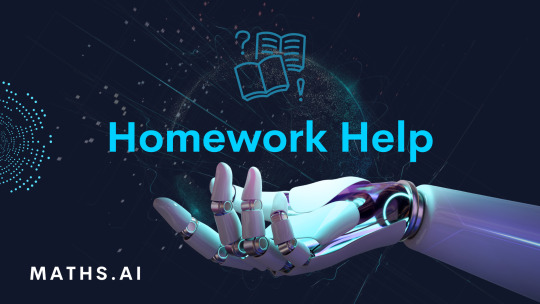
Maths homework can be a challenging subject for many students, often leaving them feeling overwhelmed and in need of assistance. Fortunately, with advancements in technology, students now have access to various online resources that can help them understand and solve complex maths problems. One such revolutionary solution is maths.ai, which combines the power of artificial intelligence and educational expertise to provide personalised and effective support for students' math homework. In this article, we will explore the benefits of maths.ai and highlight some easy ways students can leverage these platforms to enhance their learning experience.
Understanding Maths.aiMaths.ai utilises cutting-edge technology to deliver tailored support to students struggling with maths homework. This platform incorporates advanced algorithms and machine learning techniques to analyse students' needs, identify areas of difficulty, and provide targeted assistance. By utilizing natural language processing and pattern recognition, maths.ai can understand students' queries and provide step-by-step explanations, interactive tutorials, practice problems, and even real-time feedback.
Benefits of Maths.aia. Personalised Learning: One of the significant advantages of maths.ai is its ability to offer personalised learning experiences. Through continuous analysis of students' performance and progress, this platform can adapt to individual needs and provide customised content, ensuring students receive the help they require at their specific skill level.
b. Feedback and Correction : Maths.ai offers real-time feedback on students' solutions, enabling them to identify and correct mistakes immediately. This timely feedback encourages active learning and helps students develop a deeper understanding of mathematical concepts by learning from their errors.
c. Accessible Anytime, Anywhere: With maths.ai, students can access help and resources anytime and anywhere if they have an internet connection. This flexibility allows students to work at their own pace, making learning more convenient and accommodating individual schedules.
d. Enhanced Engagement: Maths.ai often employs interactive interfaces, gamified learning elements, and visualisations to engage students and make maths more enjoyable. These features help create a more interactive and immersive learning environment, which can significantly improve students' motivation and interest in mathematics.
Easy Ways to Leverage Maths.ai for Homework Helpa. Step-by-Step Explanations: When encountering a challenging maths problem, students can input the question into maths.ai.The platform will then provide a detailed step-by-step explanation of how to solve the problem, breaking it down into manageable parts. This feature allows students to grasp the underlying concepts and apply them to similar problems independently.
b. Real-Time Assistance: Students can benefit from real-time assistance by utilising chatbots available on maths.ai. This tool can answer specific questions, clarify doubts, and provide additional guidance when students need immediate help. The interactive nature of these resources creates a dynamic learning experience, resembling the support of a human tutor.
c. Progress Tracking and Analytics: Maths.ai tracks students' progress and provides analytics to help identify areas of improvement. Students can review their performance, monitor their growth, and identify weak areas that require additional attention. This feedback loop allows students to focus on specific topics and measure their progress over time.
Overcoming Potential LimitationsWhile maths.ai has immense potential to assist students with their maths homework, it is essential to acknowledge their limitations. This platform rely on programmed algorithms and data, which means it may not always be able to address every individual's unique learning needs. Additionally, the absence of human interaction can sometimes hinder students who benefit from direct personal guidance. It is crucial for students to use the platform as a supplement to their regular learning routine and seek human assistance when necessary.
Maths.ai revolutionised the way students seek help with their maths homework. This platform provides personalised support, instant feedback, and extensive resources, making maths more accessible and engaging for learners. By leveraging the features offered by maths.ai students can enhance their understanding, develop problem-solving skills, and build confidence in mathematics. As technology continues to advance. Maths.ai will likely play an increasingly vital role in the education landscape, empowering students and transforming the way they learn maths.
0 notes
Text
Unleashing the Power of Maths.ai: Your 24/7 Maths Problem Solver
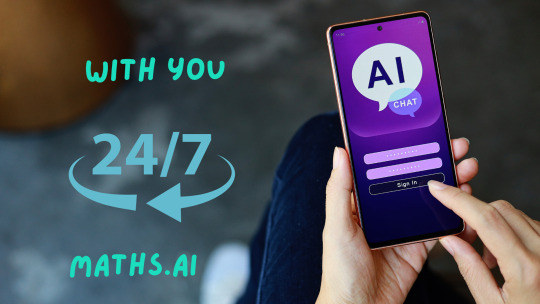
In the fast-paced digital era, the integration of Artificial Intelligence (AI) has revolutionised the way we tackle complex tasks. From driving cars to personalizing our online experiences, AI has become an indispensable part of our lives. Now, imagine harnessing the power of AI to conquer the challenges of mathematics. Welcome to an innovative platform that provides students with 24/7 assistance in solving math problems. In this article, we will explore the incredible benefits and functionalities of maths.ai dedicated to helping students overcome their maths doubts.
The Rise of AI in EducationArtificial Intelligence has already made a significant impact in the field of education. By leveraging AI algorithms and machine learning techniques, educational platforms have become more personalised, adaptive, and efficient. This transformative technology has the potential to enhance students' learning experiences by providing tailored solutions and immediate feedback.
Introducing the Maths Problem SolverMaths.ai is a cutting-edge tool designed to assist students at any time of the day. This web-based platform utilises advanced algorithms to analyse and solve complex mathematical equations, helping students comprehend and solve problems more effectively. Whether it's algebra, calculus, geometry, or statistics, maths.ai is equipped to handle a wide range of mathematical concepts.
How It WorksIt is a user-friendly interface, making it accessible to students of all ages and skill levels. To get started, students can simply enter their maths problem into the system. The AI algorithms then analyse the problem, breaking it down into manageable steps. Maths.ai provides a step-by-step solution, along with explanations and relevant formulas, empowering students to understand the underlying concepts.
Instant Feedback and Learning OpportunitiesOne of the key advantages of maths.ai is the provision of instant feedback. Unlike traditional methods, where students may have to wait for teachers or tutors to check their work, this platform ensures immediate verification of their solutions. If an error is detected, the AI system provides helpful feedback and guidance, enabling students to correct their mistakes and learn from them.
Adaptive Learning and Personalized SupportMaths.ai goes beyond merely providing solutions. It adapts to the individual learning needs of each student, offering personalized support and guidance. By analysing a student's performance and understanding, the system can identify areas where they may be struggling and suggest additional practice exercises or supplementary study materials. This personalised approach helps students build a strong foundation in mathematics.
Building Problem-Solving SkillsMathematics is not just about finding the right answers but also developing problem-solving skills. Maths.ai nurtures these skills by encouraging students to think critically and explore alternative approaches. By presenting multiple solution paths and offering insights into different problem-solving strategies, the platform instils a sense of creativity and analytical thinking in students.
Supplementing Classroom EducationIt complements traditional classroom instruction by providing continuous support outside of school hours. Students can access the platform whenever they encounter difficulties or need additional practice. This 24/7 availability ensures that learning is not confined to the classroom and helps students stay on track with their studies.
Ethical Considerations and LimitationsWhile maths.ai is an incredible resource, it is essential to acknowledge its limitations. The system relies on predefined algorithms and may not address every unique problem or approach. Moreover, students should use the platform as a learning tool rather than a substitute for active engagement in the learning process.
In the digital age, AI has emerged as a powerful ally in the pursuit of knowledge. Maths.ai represents a groundbreaking solution for students grappling with maths doubts. By providing instant feedback, personalised support, and fostering problem-solving skills, this innovative platform ensures that students receive the assistance they need, whenever they need it. Embrace the future of learning with maths.ai and unleash your mathematical potential like never before.
0 notes